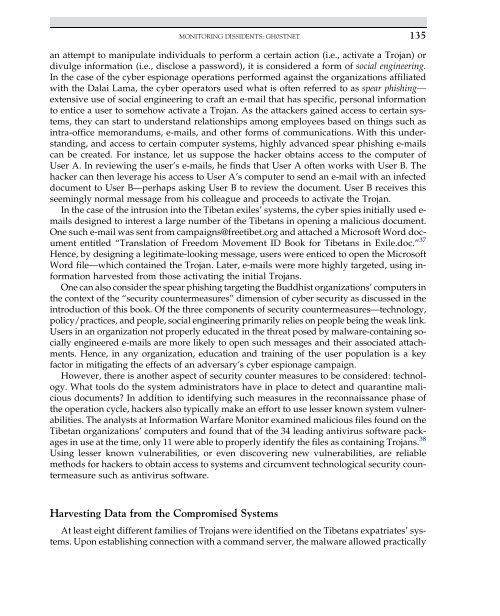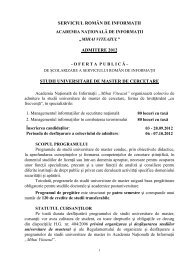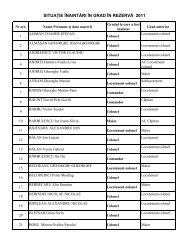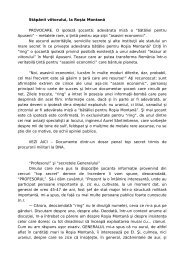Introduction to Cyber-Warfare - Proiect SEMPER FIDELIS
Introduction to Cyber-Warfare - Proiect SEMPER FIDELIS
Introduction to Cyber-Warfare - Proiect SEMPER FIDELIS
Create successful ePaper yourself
Turn your PDF publications into a flip-book with our unique Google optimized e-Paper software.
MONITORING DISSIDENTS: GH0STNET135an attempt <strong>to</strong> manipulate individuals <strong>to</strong> perform a certain action (i.e., activate a Trojan) ordivulge information (i.e., disclose a password), it is considered a form of social engineering.In the case of the cyber espionage operations performed against the organizations affiliatedwith the Dalai Lama, the cyber opera<strong>to</strong>rs used what is often referred <strong>to</strong> as spear phishing—extensive use of social engineering <strong>to</strong> craft an e-mail that has specific, personal information<strong>to</strong> entice a user <strong>to</strong> somehow activate a Trojan. As the attackers gained access <strong>to</strong> certain systems,they can start <strong>to</strong> understand relationships among employees based on things such asintra-office memorandums, e-mails, and other forms of communications. With this understanding,and access <strong>to</strong> certain computer systems, highly advanced spear phishing e-mailscan be created. For instance, let us suppose the hacker obtains access <strong>to</strong> the computer ofUser A. In reviewing the user’s e-mails, he finds that User A often works with User B. Thehacker can then leverage his access <strong>to</strong> User A’s computer <strong>to</strong> send an e-mail with an infecteddocument <strong>to</strong> User B—perhaps asking User B <strong>to</strong> review the document. User B receives thisseemingly normal message from his colleague and proceeds <strong>to</strong> activate the Trojan.In the case of the intrusion in<strong>to</strong> the Tibetan exiles’ systems, the cyber spies initially used e-mails designed <strong>to</strong> interest a large number of the Tibetans in opening a malicious document.One such e-mail was sent from campaigns@freetibet.org and attached a Microsoft Word documententitled “Translation of Freedom Movement ID Book for Tibetans in Exile.doc.” 37Hence, by designing a legitimate-looking message, users were enticed <strong>to</strong> open the MicrosoftWord file—which contained the Trojan. Later, e-mails were more highly targeted, using informationharvested from those activating the initial Trojans.One can also consider the spear phishing targeting the Buddhist organizations’ computers inthe context of the “security countermeasures” dimension of cyber security as discussed in theintroduction of this book. Of the three components of security countermeasures—technology,policy/practices, and people, social engineering primarily relies on people being the weak link.Users in an organization not properly educated in the threat posed by malware-containing sociallyengineered e-mails are more likely <strong>to</strong> open such messages and their associated attachments.Hence, in any organization, education and training of the user population is a keyfac<strong>to</strong>r in mitigating the effects of an adversary’s cyber espionage campaign.However, there is another aspect of security counter measures <strong>to</strong> be considered: technology.What <strong>to</strong>ols do the system administra<strong>to</strong>rs have in place <strong>to</strong> detect and quarantine maliciousdocuments? In addition <strong>to</strong> identifying such measures in the reconnaissance phase ofthe operation cycle, hackers also typically make an effort <strong>to</strong> use lesser known system vulnerabilities.The analysts at Information <strong>Warfare</strong> Moni<strong>to</strong>r examined malicious files found on theTibetan organizations’ computers and found that of the 34 leading antivirus software packagesin use at the time, only 11 were able <strong>to</strong> properly identify the files as containing Trojans. 38Using lesser known vulnerabilities, or even discovering new vulnerabilities, are reliablemethods for hackers <strong>to</strong> obtain access <strong>to</strong> systems and circumvent technological security countermeasuresuch as antivirus software.Harvesting Data from the Compromised SystemsAt least eight different families of Trojans were identified on the Tibetans expatriates’ systems.Upon establishing connection with a command server, the malware allowed practically
















